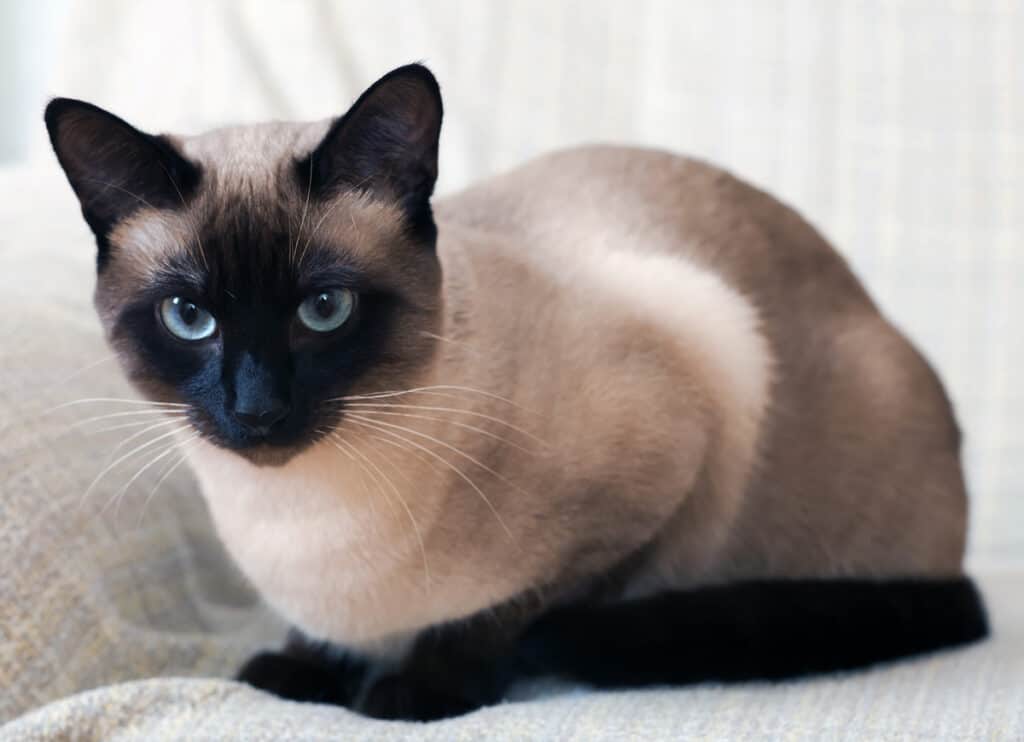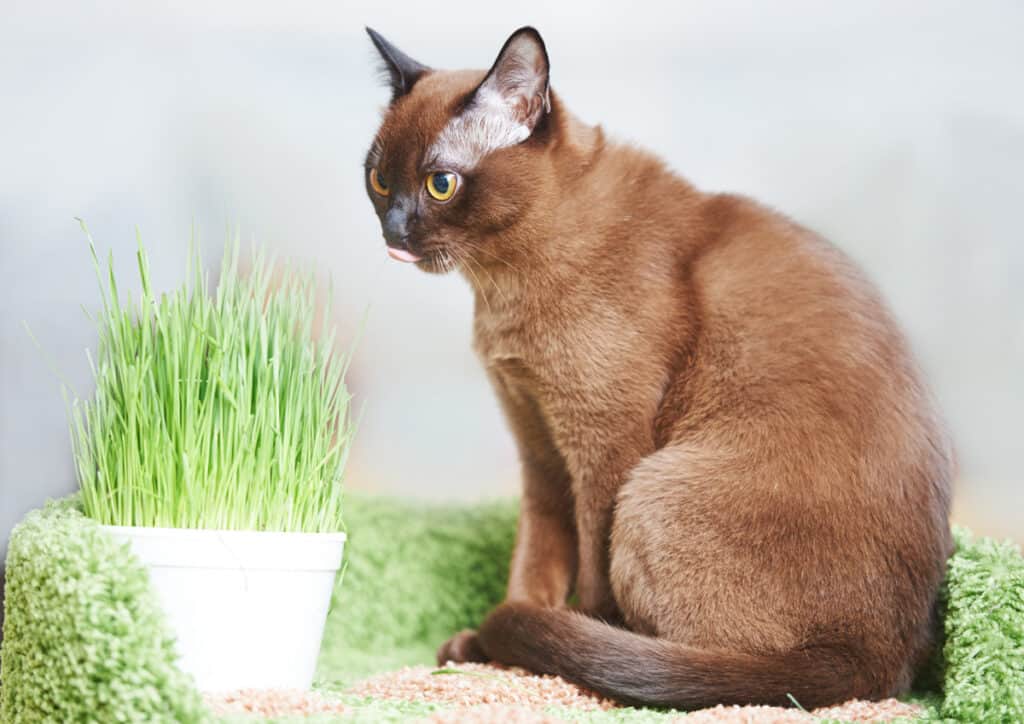Have you ever wondered how animals get their colors? What determines why their tails are black, but their bellies are white? Depending on the animal, the answer may vary, but the answer relates to the cat’s skin temperature for some domestic cats. Think of any cat like a Siamese or a Burmese with some darker features than the rest of the body like the ears, tails, paws, face, and even their cute little noses.
How an Enzyme Affects Some Cat’s Fur Color
These color differences occur because of a temperature-sensitive mutation that exists in the enzymes in the metabolic pathway that control or determine the color of a cat’s fur. In fact, it is the same enzyme responsible for albinism.
When kittens are born, they have been kept warm in their mother’s womb for their entire lives. They are born entirely without pigment, completely white, but this doesn’t mean they have albinism. Upon entering the world, they become sensitive to temperature changes, and their face and extremities are usually the first to begin to feel cold.
So, where it’s cold, or even just a slightly different temperature, more melanin will be produced, meaning that more pigment will be deposited, so to speak, in those areas. It takes a few weeks for the first signs of color to show up in a newborn kitten.
Colorpoint Coat Pattern
A cat with a colorpoint pattern will typically have darker colors on its face, ears, feet, and tail, with a lighter version of that same dark color everywhere else on the body. So, for example, with a Siamese cat, the ears, tail, face, and feet are all black, but the rest of the body is usually a significantly lighter version of black, like silver or gray or even a very light tan.

Siamese cats can have multiple color variations, but they are all genetically identical in their genetic makeup. There are four color points officially recognized by the Cat Fanciers Association and include:
- Seal Point: Seal-brown colorpoints, cream-colored bodies
- Chocolate Point: Chocolate colorpoints, ivory bodies
- Blue Point: Blue hue/silver points, bluish-colored bodies
- Lilac Point: Grayish pink, cinnamon pink points, light ivory bodies
In addition to Siamese, the kind of cats the colorpoint characteristic is most commonly associated with, other domesticated cats like the Balinese, Birman, Thai, Himalayan, Ragdoll, and Snowshoe cats are examples of cats that are considered to be colorpoint cat breeds.

Shaving Can Darken a Cat’s Fur Coat
If a colorpoint cat undergoes a procedure where it needs to get its fur shaved, the skin in the area that was shaved would be cooler than the rest of the body, so the cat’s fur would grow back darker like it grew on its ears and paws.
Eventually, it will return to normal after a new hair growth cycle as the old hair is shed. You might notice this if you take your cat in for a blood draw and they shave its leg or if your cat undergoes a routine spay surgery. In both cases, the fur that has been shaved will more than likely grow back at least a shade or two darker, if not several shades darker.

The enzyme tyrosinase is responsible for converting tyrosine to melanin. In the case of colorpoint cats, with their temperature-sensitive mutation, tyrosinase becomes damaged by heat and cannot perform its job. When it is damaged by heat, the tyrosinase can’t produce as much pigment or melanin, which is why the fur on the warmer parts of the body is so much paler while the fur on cooler parts like the extremities or parts that have been shaved become darker.
On the cooler parts of the body, where the tyrosinase isn’t being damaged by heat, it can convert tyrosine to melanin, which is where we’ll see darker colors deposited on the cats’ body.
A Form of Albinism
The gene itself is a form of albinism in that it prevents pigment from developing in a cat’s coat because of its sensitivity to body temperature. If the cat’s body temperature is too warm, it simply will not produce any melanin.
Climate Can Also Affect These Cat’s Coat Color
And it’s actually not just the cat’s body temperature either that seems to affect it. Outside climate and temperature make a difference as well. Cats with the color point gene who live in warmer climates will have lighter-colored fur, and cats who live in cooler climates will have darker-colored fur. Also, as a result of the color point gene, all color point cats have blue eyes.
Variations in a Cat’s Temperature Sensitivity
Some colorpoint cats are less temperature sensitive than others. For example, Burmese cats have a color point gene or enzyme that isn’t nearly as temperature-sensitive as other cats. This is why they are quite a bit darker than other colorpoint cats.

In some circles, Burmese cats are considered to be in a different category altogether from Siamese cats. In truth, there are two temperature-sensitive genes or enzymes, one found in Siamese cats and one found in Burmese and some Tonkinese cats.
Instead of calling Burmese and Tonkinese cats pointed or colorpoint cats like the Siamese, many people refer to them as Minks instead. It makes sense for many to have these cats categorized separately as they possess two different temperature-sensitive enzymes that produce visible differences in the cat’s fur.
The Siamese temperature-sensitive enzyme is quite a bit more sensitive to heat and more susceptible to heat damage. This temperature sensitivity is why Siamese cats are typically very light in color, as the enzyme never allows their fur to grow darker. On the other hand, Minks’ temperature-sensitive enzymes aren’t nearly as sensitive and therefore don’t inhibit melanin production as much, allowing the cats to have much darker fur.
Many factors can affect the color of a cat’s fur. Still, for certain unique breeds of cats like Siamese and Burmese, a temperature-sensitive enzyme holds the primary responsibility for their color. This enzyme can only produce melanin when a cat’s temperature is cooler, which is why these cats have darker faces, ears, paws, and tails, all cooler areas of the body.
References
Robinson, R. (1975). The Domestic Cat. Handbook of Genetics: Volume 4 Vertebrates of Genetic Interest, 351.
Cohen, Arna (2012) “Anything But Ordinary,” Serial – All Animals 2009-15: Vol. 14: Iss. 6, Article 6.
https://www.wellbeingintlstudiesrepository.org/allanimals/vol14/iss6/6






